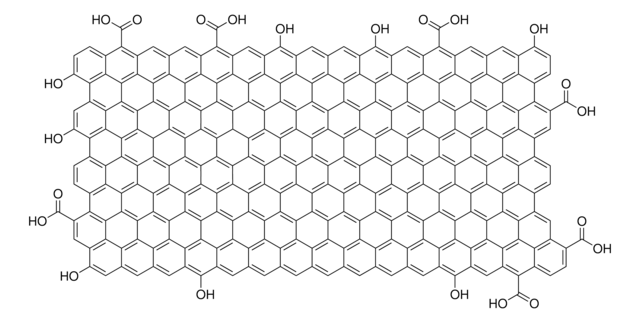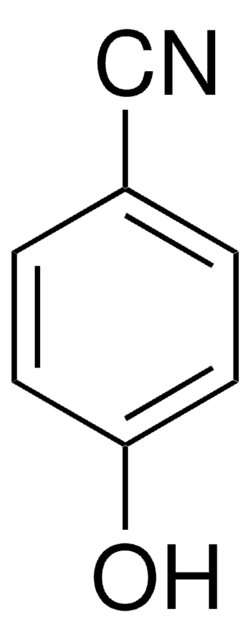All Photos(1)
About This Item
Linear Formula:
F3C6H2OH
CAS Number:
Molecular Weight:
148.08
MDL number:
UNSPSC Code:
12352100
PubChem Substance ID:
NACRES:
NA.22
Recommended Products
Assay
99%
form
solid
mp
49-51 °C (lit.)
SMILES string
Oc1c(F)cc(F)cc1F
InChI
1S/C6H3F3O/c7-3-1-4(8)6(10)5(9)2-3/h1-2,10H
InChI key
QQFWMPUXPLBWTG-UHFFFAOYSA-N
General description
2,4,6-Trifluorophenol is a halogen-substituted phenol. Peroxidase oxidation of 2,4,6-trifluorophenol has been reported. Association of phenol and 2,4,6-trifluorophenol has been investigated by 1H- and 19F-NMR spectroscopy.
Application
2,4,6-Trifluorophenol may be used in an indirect enzyme-linked immunosorbent assay (ELISA) for the biological monitoring of 2,4,6-trichlorophenol.
Signal Word
Warning
Hazard Statements
Precautionary Statements
Hazard Classifications
Acute Tox. 4 Oral - Eye Irrit. 2 - Skin Irrit. 2 - STOT SE 3
Target Organs
Respiratory system
Storage Class Code
11 - Combustible Solids
WGK
WGK 3
Flash Point(F)
Not applicable
Flash Point(C)
Not applicable
Personal Protective Equipment
dust mask type N95 (US), Eyeshields, Gloves
Certificates of Analysis (COA)
Search for Certificates of Analysis (COA) by entering the products Lot/Batch Number. Lot and Batch Numbers can be found on a product’s label following the words ‘Lot’ or ‘Batch’.
Already Own This Product?
Find documentation for the products that you have recently purchased in the Document Library.
Customers Also Viewed
Revisiting the peroxidase oxidation of 2,4,6-trihalophenols: ESR detection of radical intermediates.
Bradley E Sturgeon et al.
Chemical research in toxicology, 24(11), 1862-1868 (2011-09-29)
The peroxidase oxidation of 2,4,6-trichlorophenol (TCP) has been clearly shown to result in 2,6-dichloro-1,4-benzoquinone (DCQ). DCQ is a 2-electron oxidation product of TCP that has undergone para dechlorination. Many peroxidases show similar oxidation of the substrate, TCP, to yield the
Daniela Smejkalová et al.
Environmental science & technology, 43(14), 5377-5382 (2009-08-28)
1H- and 19F-NMR measurements of spin-lattice (T1) and spin-spin (T2) relaxationtimes and diffusion ordered spectroscopy (DOSY) were applied to investigate the association of nonsubstituted (phenol (P)) and halogen-substituted (2,4-dichlorophenol (DCP); 2,4,6-trichlorophenol (TCP), and 2,4,6-trifluorophenol (TFP) phenols with a dissolved humic
Roger Galve et al.
Analytical chemistry, 74(2), 468-478 (2002-01-29)
Trichlorophenols (TCP) eliminated by the urine can be considered as potential biomarkers of exposure of many chemicals (chlorophenols, chlorophenoxy acid herbicides, prochloraz, lindane, hexachlorobenzene, etc). High-throughput screening methods are necessary to carry out efficient monitoring programs that may help to
Erin M Kollitz et al.
Toxicological sciences : an official journal of the Society of Toxicology, 163(1), 226-239 (2018-02-07)
Brominated phenolic compounds (BPCs) are found in the environment, and in human and wildlife tissues, and some are considered to have endocrine disrupting activities. The goal of this study was to determine how structural differences of 3 BPC classes impact
Marie A Colucci et al.
Journal of medicinal chemistry, 50(23), 5780-5789 (2007-10-20)
NAD(P)H:quinone oxidoreductase 1 is a proposed target in pancreatic cancer. We describe the synthesis of a series of indolequinones, based on the 5- and 6-methoxy-1,2-dimethylindole-4,7-dione chromophores with a range of phenolic leaving groups at the (indol-3-yl)methyl position. The ability of
Our team of scientists has experience in all areas of research including Life Science, Material Science, Chemical Synthesis, Chromatography, Analytical and many others.
Contact Technical Service












